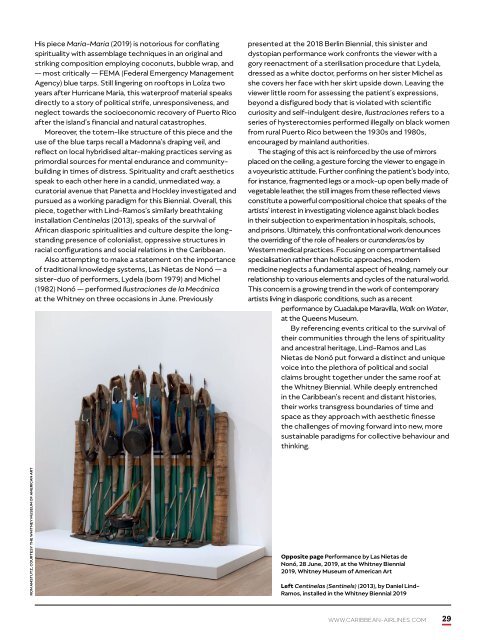Caribbean Beat — September/October 2019 (#159)
A calendar of events; music, film, and book reviews; travel features; people profiles, and much more.
A calendar of events; music, film, and book reviews; travel features; people profiles, and much more.
You also want an ePaper? Increase the reach of your titles
YUMPU automatically turns print PDFs into web optimized ePapers that Google loves.
His piece Maria-Maria (<strong>2019</strong>) is notorious for conflating<br />
spirituality with assemblage techniques in an original and<br />
striking composition employing coconuts, bubble wrap, and<br />
<strong>—</strong> most critically <strong>—</strong> FEMA (Federal Emergency Management<br />
Agency) blue tarps. Still lingering on rooftops in Loíza two<br />
years after Hurricane Maria, this waterproof material speaks<br />
directly to a story of political strife, unresponsiveness, and<br />
neglect towards the socioeconomic recovery of Puerto Rico<br />
after the island’s financial and natural catastrophes.<br />
Moreover, the totem-like structure of this piece and the<br />
use of the blue tarps recall a Madonna’s draping veil, and<br />
reflect on local hybridised altar-making practices serving as<br />
primordial sources for mental endurance and communitybuilding<br />
in times of distress. Spirituality and craft aesthetics<br />
speak to each other here in a candid, unmediated way, a<br />
curatorial avenue that Panetta and Hockley investigated and<br />
pursued as a working paradigm for this Biennial. Overall, this<br />
piece, together with Lind-Ramos’s similarly breathtaking<br />
installation Centinelas (2013), speaks of the survival of<br />
African diasporic spiritualities and culture despite the longstanding<br />
presence of colonialist, oppressive structures in<br />
racial configurations and social relations in the <strong>Caribbean</strong>.<br />
Also attempting to make a statement on the importance<br />
of traditional knowledge systems, Las Nietas de Nonó <strong>—</strong> a<br />
sister-duo of performers, Lydela (born 1979) and Michel<br />
(1982) Nonó <strong>—</strong> performed Ilustraciones de la Mecánica<br />
at the Whitney on three occasions in June. Previously<br />
presented at the 2018 Berlin Biennial, this sinister and<br />
dystopian performance work confronts the viewer with a<br />
gory reenactment of a sterilisation procedure that Lydela,<br />
dressed as a white doctor, performs on her sister Michel as<br />
she covers her face with her skirt upside down. Leaving the<br />
viewer little room for assessing the patient’s expressions,<br />
beyond a disfigured body that is violated with scientific<br />
curiosity and self-indulgent desire, Ilustraciones refers to a<br />
series of hysterectomies performed illegally on black women<br />
from rural Puerto Rico between the 1930s and 1980s,<br />
encouraged by mainland authorities.<br />
The staging of this act is reinforced by the use of mirrors<br />
placed on the ceiling, a gesture forcing the viewer to engage in<br />
a voyeuristic attitude. Further confining the patient’s body into,<br />
for instance, fragmented legs or a mock-up open belly made of<br />
vegetable leather, the still images from these reflected views<br />
constitute a powerful compositional choice that speaks of the<br />
artists’ interest in investigating violence against black bodies<br />
in their subjection to experimentation in hospitals, schools,<br />
and prisons. Ultimately, this confrontational work denounces<br />
the overriding of the role of healers or curanderas/os by<br />
Western medical practices. Focusing on compartmentalised<br />
specialisation rather than holistic approaches, modern<br />
medicine neglects a fundamental aspect of healing, namely our<br />
relationship to various elements and cycles of the natural world.<br />
This concern is a growing trend in the work of contemporary<br />
artists living in diasporic conditions, such as a recent<br />
performance by Guadalupe Maravilla, Walk on Water,<br />
at the Queens Museum.<br />
By referencing events critical to the survival of<br />
their communities through the lens of spirituality<br />
and ancestral heritage, Lind-Ramos and Las<br />
Nietas de Nonó put forward a distinct and unique<br />
voice into the plethora of political and social<br />
claims brought together under the same roof at<br />
the Whitney Biennial. While deeply entrenched<br />
in the <strong>Caribbean</strong>’s recent and distant histories,<br />
their works transgress boundaries of time and<br />
space as they approach with aesthetic finesse<br />
the challenges of moving forward into new, more<br />
sustainable paradigms for collective behaviour and<br />
thinking.<br />
Ron Amstutz, courtesy the Whitney Museum of American Art<br />
Opposite page Performance by Las Nietas de<br />
Nonó, 28 June, <strong>2019</strong>, at the Whitney Biennial<br />
<strong>2019</strong>, Whitney Museum of American Art<br />
Left Centinelas (Sentinels) (2013), by Daniel Lind-<br />
Ramos, installed in the Whitney Biennial <strong>2019</strong><br />
WWW.CARIBBEAN-AIRLINES.COM 29

















